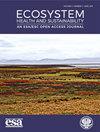Bridging experimental and monitoring research for visible foliar injury as bio-indicator of ozone impacts on forests
IF 3.4
2区 环境科学与生态学
Q1 ECOLOGY
引用次数: 3
Abstract
ABSTRACT Tropospheric ozone (O3) is a phytotoxic air pollutant and the O3-induced visible foliar injury (O3 VFI) is a biomarker. A recently developed Free-air O3 eXposure (FO3X) is a promising facility to verify field-observed “O3-like” VFIs and to establish a flux-based threshold for the O3 VFI onset. The present study compared O3-like VFI registered in the southern European forest sites with actual O3 VFI observed in a FO3X experiment. The O3-like VFIs were evaluated by eye in forests and thus it was subjective. According to the imaging analysis, we firstly demonstrated that major parts of the colors were similar in the field and the FO3X. The color pallets for O3 VFI was species-specific and considered a advanced tool for the O3 VFI diagnosis. In addition, we calculated a flux-based threshold for the O3 VFI onset at the FO3X based on a Phytotoxic Ozone Dose (POD1), which ranged from 4.9 to 18.1 mmol m−2 POD1. This FO3X-derived threshold partly explained but did not necessarily match with the observation for several tree species in actual forests. The multivariate analysis showed that O3 VFI was decreased by the presence of various species and suggested the importance of continuous monitoring activities in the field for the further analysis.作为臭氧对森林影响生物指标的叶面可见损伤衔接实验与监测研究
对流层臭氧(O3)是一种植物毒性空气污染物,O3诱导的可见叶面损伤(O3 VFI)是一种生物标志物。最近开发的自由空气O3暴露(FO3X)是一种很有前途的设备,可以验证现场观察到的“类O3”VFI,并为O3 VFI的发作建立基于通量的阈值。本研究将在南欧森林站点记录的O3样VFI与FO3X实验中观察到的实际O3 VFI进行了比较。在森林中,o3样vfi是用肉眼评价的,具有主观性。根据成像分析,我们首先证明了野外和FO3X的主要部分颜色相似。O3 VFI的色盘是物种特异性的,被认为是O3 VFI诊断的先进工具。此外,我们基于植物毒性臭氧剂量(POD1)计算了FO3X中O3 VFI发作的通量阈值,范围为4.9至18.1 mmol m−2 POD1。这个fo3x衍生的阈值部分解释了,但不一定与实际森林中几种树种的观测结果相匹配。多变量分析表明,不同物种的存在降低了O3 VFI,表明野外持续监测活动对进一步分析的重要性。
本文章由计算机程序翻译,如有差异,请以英文原文为准。
求助全文
约1分钟内获得全文
求助全文
来源期刊

Ecosystem Health and Sustainability
Environmental Science-Management, Monitoring, Policy and Law
CiteScore
7.10
自引率
2.00%
发文量
40
审稿时长
22 weeks
期刊介绍:
Ecosystem Health and Sustainability publishes articles on advances in ecology and sustainability science, how global environmental change affects ecosystem health, how changes in human activities affect ecosystem conditions, and system-based approaches for applying ecological science in decision-making to promote sustainable development. Papers focus on applying ecological theory, principles, and concepts to support sustainable development, especially in regions undergoing rapid environmental change. Papers on multi-scale, integrative, and interdisciplinary studies, and on international collaborations between scientists from industrialized and industrializing countries are especially welcome.
Suitable topics for EHS include:
• Global, regional and local studies of international significance
• Impact of global or regional environmental change on natural ecosystems
• Interdisciplinary research involving integration of natural, social, and behavioral sciences
• Science and policy that promote the use of ecological sciences in decision making
• Novel or multidisciplinary approaches for solving complex ecological problems
• Multi-scale and long-term observations of ecosystem evolution
• Development of novel systems approaches or modeling and simulation techniques
• Rapid responses to emerging ecological issues.
 求助内容:
求助内容: 应助结果提醒方式:
应助结果提醒方式:


